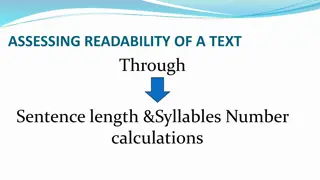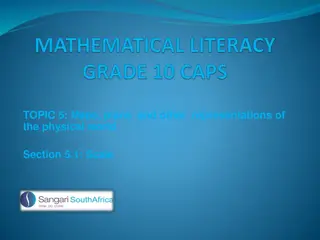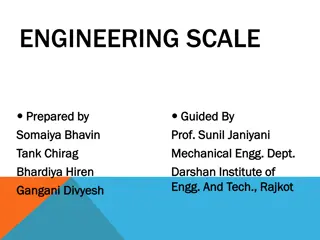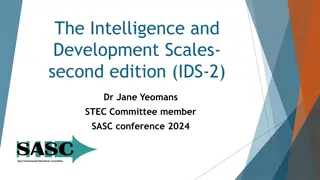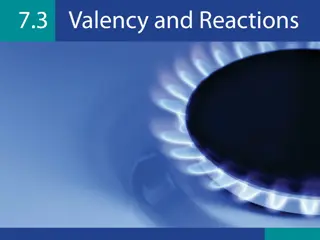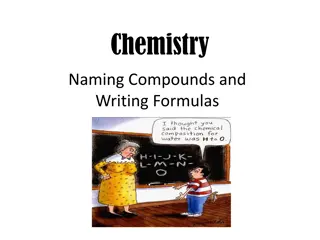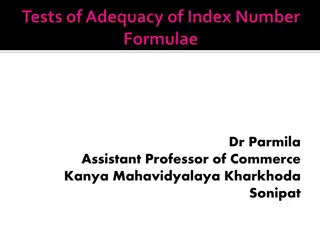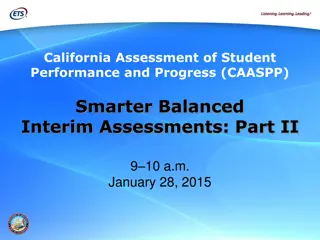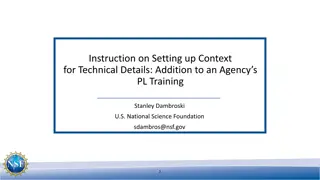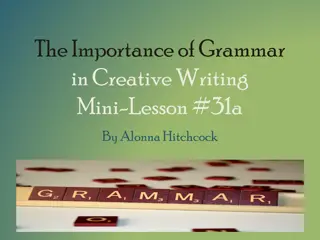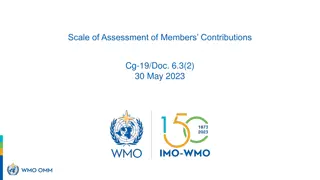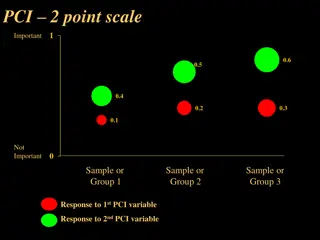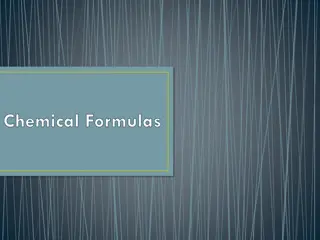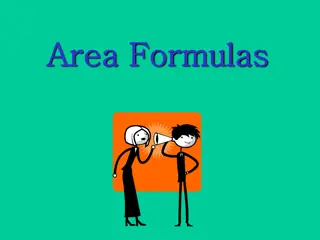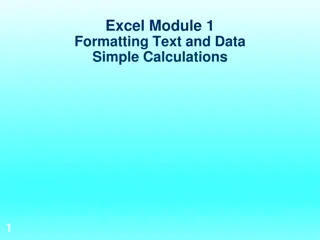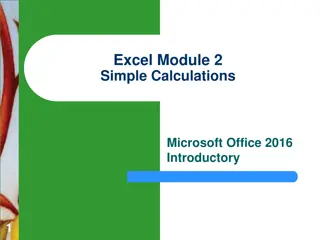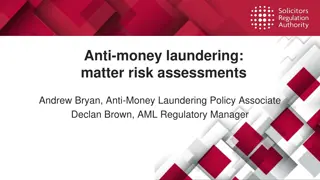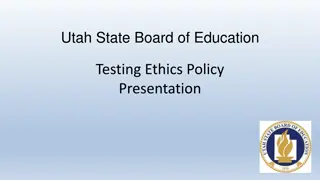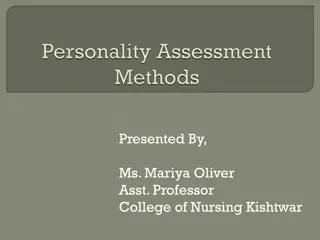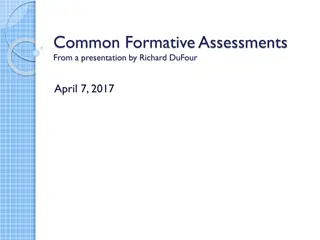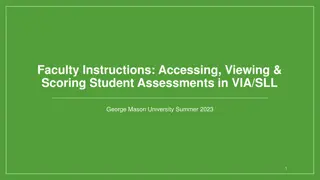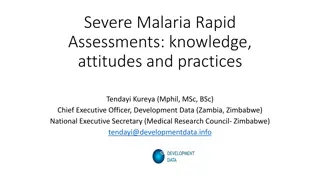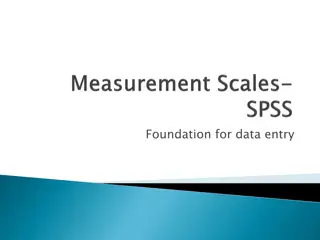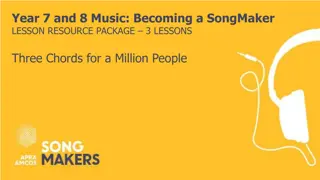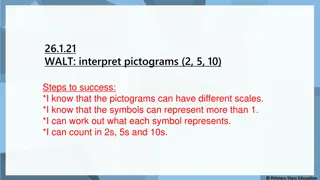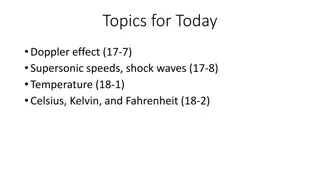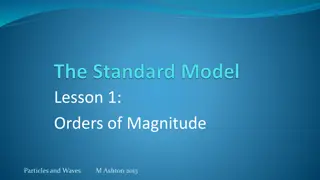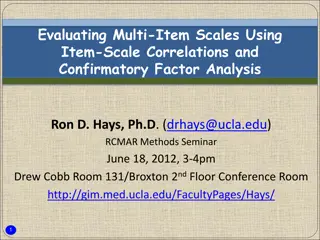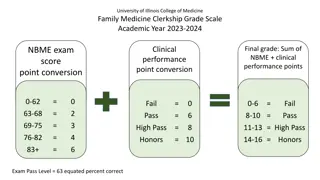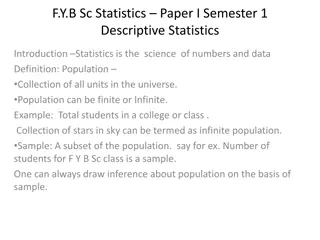Understanding Readability: Formulas, Scales, and Assessments
Readability is crucial for effective communication, and this module explores its significance, common scales/formulas, and tools for assessing resources. Factors impacting readability and the importance of text leveling are discussed, emphasizing the role of readability in enhancing reader comprehension and overall communication success.
Uploaded on Sep 17, 2024 | 1 Views
Download Presentation

Please find below an Image/Link to download the presentation.
The content on the website is provided AS IS for your information and personal use only. It may not be sold, licensed, or shared on other websites without obtaining consent from the author. Download presentation by click this link. If you encounter any issues during the download, it is possible that the publisher has removed the file from their server.
E N D
Presentation Transcript
READABILITY FORMULAS, SCALES & ASSESSMENTS CONTINUING EDUCATION MODULE #1
INTRODUCTION In this presentation we will: Talk about the importance of plain (clear) language Review some of the common Readability Scales/Formulas Identify tools to know which resources to use for learners
DEFINING READABILITY Readability is the ease with which a reader can understand a written text. In natural language, the readability of text depends on its content (the complexity of its vocabulary and syntax) and its presentation (such as typographic aspects such as font size, line height, character spacing and line length).
READABILITY FACTORS Researchers have used various factors to measure readability, such as: Speed of perception Visibility Reflex blink technique Eye movements Fatigue in reading N-gram analysis Perceptibility at a distance Perceptibility in peripheral vision Rate of Work (reading speed) Word Difficulty Cognitively- motivated features
WHY IS IT IMPORTANT? Readability is more than simply legibility which is a measure of how easily a reader can distinguish individual letters or characters from each other. Higher readability eases reading effort and speed for any reader, but it is especially important for those who do not have high reading comprehension. In readers with average or poor comprehension, raising the readability level of text from mediocre to good, can make a difference between success and failure of its communication goals.
TEXT LEVELING The earliest reading ease assessment is the subjective judgment termed text leveling. Formulas do not fully address the various content, purpose, design, visual input, and organization of a text. Text leveling is commonly used to rank the reading ease of texts in areas where reading difficulties are easy to identify, such as books for young children. At higher levels, ranking reading ease becomes more difficult, as individual difficulties become harder to identify. This has led to better ways to assess reading ease.
VOCABULARY FREQUENCY LISTS In the 1920s, the scientific movement in education looked for tests to measure students' achievement to aid in curriculum development. Teachers and educators had long known that, to improve reading skill, readers especially beginning readers need reading material that closely matches their ability. University-based psychologists did much of the early research, which was later taken up by textbook publishers. Word skill was the best sign of intellectual development, and the strongest predictor of reading ease. In 1921, Thorndike published Teachers Word Book, which contained the frequencies of 10,000 words. It made it easier for teachers to choose books that matched class reading skills. It also provided a basis for future research on reading ease. Until computers came along, word frequency lists were the best aids for grading reading ease of texts. In 1981 the World Book Encyclopedia listed the grade levels of 44,000 words.
EARLY ADULT READABILITY FORMULAS During the recession of the 1930s, the U.S. government invested in adult education. In 1931, Douglas Waples and Ralph Tyler published What Adults Want to Read About. It was a two-year study of adult reading interests. Their book showed not only what people read but what they would like to read. They found that many readers lacked suitable reading materials: they would have liked to learn but the reading materials were too hard for them. Lyman Bryson, of Columbia University, found that many adults had poor reading ability due to poor education. Even though colleges had long tried to teach how to write in a clear and readable style, Bryson found that it was rare. He wrote that such language is the result of a "...discipline and artistry that few people who have ideas will take the trouble to achieve... If simple language were easy, many of our problems would have been solved long ago. Bryson helped set up the Readability Laboratory at the College. Two of his students were Irving Lorge and Rudolf Flesch.
DEVELOPING READABILITY FORMULAS RALPH OJEMANN In 1934, Ojemann investigated adult reading skills, factors that most directly affect reading ease, and causes of each level of difficulty. He did not invent a formula, but a method for assessing the difficulty of materials for parent education. He was the first to assess the validity of this method by using 16 magazine passages tested on actual readers. He evaluated 14 measurable and three reported factors that affect reading ease. Ojemann emphasized the reported features, such as whether the text was coherent or unduly abstract. He used his 16 passages to compare and judge the reading ease of other texts, a method now called scaling. He showed that even though these factors cannot be measured, they cannot be ignored.
DEVELOPING READABILITY FORMULAS WILLIAM S. GRAY & BERNICE LEARY In 1935, Gray and Leary published What Makes a Book Readable, one of the most important books in readability research. Like Dale and Tyler, they focused on what makes books readable for adults of limited reading ability. Their book included the first scientific study of the reading skills of American adults. The sample included 1,690 adults from a variety of settings and regions. The test used a number of passages from newspapers, magazines, and books as well as a standard reading test. They found a mean grade score of 7.81 (eighth month of the seventh grade). About one-third read at the 2nd to 6th- grade level, one-third at the 7th to 12th-grade level, and one-third at the 13th 17th grade level.
DEVELOPING READABILITY FORMULAS GRAY & LEARY (CONTINUED) The authors emphasized that one-half of the adult population at that time lacked suitable reading materials. They wrote, "For them, the enriching values of reading are denied unless materials reflecting adult interests are adapted to their needs." The poorest readers, one-sixth of the adult population, need "simpler materials for use in promoting functioning literacy and in establishing fundamental reading habits." Gray and Leary then analyzed 228 variables that affect reading ease and divided them into four types: Content Style Format Organization They found that content was most important, followed closely by style. Third was format, followed closely by organization. They found no way to measure content, format, or organization but they could measure variables of style.
DEVELOPING READABILITY FORMULAS GRAY & LEARY (CONTINUED) Among the 17 significant measurable style variables, they selected five to create a formula: Average sentence length Number of different hard words Number of personal pronouns Percentage of unique words Number of prepositional phrases Their formula had a correlation of .645 with comprehension as measured by reading tests given to about 800 adults.
DEVELOPING READABILITY FORMULAS IRVING LORGE In 1939, Irving Lorge published an article that reported other combinations of variables that indicate difficulty more accurately than the ones Gray and Leary used. His research also showed that, "The vocabulary load is the most important factor for reading difficulty. In 1944, Lorge published his Lorge Index, a readability formula that used three variables and set the stage for simpler and more reliable formulas that followed. By 1940, investigators had: Successfully used statistical methods to analyze reading ease Found that unusual words and sentence length were among the first causes of reading difficulty Used vocabulary and sentence length in formulas to predict reading ease
THE FLESCH FORMULAS In 1943, Rudolf Flesch published his PhD dissertation,Marks of a Readable Style, which included a readability formula to predict the difficulty of adult reading material. Investigators in many fields began using it to improve communications. One of the variables it used was personal references, such as names and personal pronouns. In 1948, Flesch published his READING EASE formula in two parts. Rather than using grade levels, it used a scale from 0 to 100, with 0 equivalent to the 12th grade and 100 equivalent to the 4th grade. The second part of the formula predicts human interest by using personal references and the number of personal sentences. The new formula correlated 0.70 with the McCall-Crabbs reading tests.The original formula is: Reading Ease score = 206.835 (1.015 ASL) (84.6 ASW) Where: ASL = average sentence length (number of words divided by number of sentences) and ASW = average word length in syllables (number of syllables divided by number of words)
FLESCH KINCAID FORMULA Publishers discovered that the Flesch formulas could increase readership up to 60 percent. Flesch's work also made an enormous impact on journalism. The Flesch Reading Ease formula became one of the most widely-used, tested, and reliable readability metrics. In 1951, Farr, Jenkins, and Patterson simplified the formula further by changing the syllable count. In 1975, in a project sponsored by the U.S. Navy, the Reading Ease formula was recalculated to give a grade-level score. The new formula is now called the Flesch-Kincaid Grade Level formula.The Flesch Kincaid formula is one of the most popular and heavily tested formulas.
GUNNING FOG FORMULA In the 1940s, Robert Gunning helped bring readability research into the workplace. In 1944, he founded the first readability consulting firm dedicated to reducing the "fog" in newspapers and business writing. In 1952, he published The Technique of Clear Writing with his own Fog Index, a formula that correlates 0.91 with comprehension as measured by reading tests. The formula is one of the most reliable and simplest to apply: Grade level= 0.4 * ( (average sentence length) + (percentage of Hard Words) ) Where: Hard Words = words with more than two syllables.
USING GUNNING FOG Step 1: Take a sample passage of at least 100-words and count the number of exact words and sentences. Step 2: Divide the total number of words in the sample by the number of sentences to arrive at the Average Sentence Length (ASL). Step 3: Count the number of words of three or more syllables that are NOT (i) proper nouns, (ii) combinations of easy words or hyphenated words, or (iii) two-syllable verbs made into three with -es and -ed endings. Step 4: Divide this number by the number or words in the sample passage. For example, 25 long words divided by 100 words gives you 25 Percent Hard Words (PHW). Step 5: Add the ASL from Step 2 and the PHW from Step 4. Step 6: Multiply the result by 0.4. The Fog Index has also undergone important changes to enable computerization of this formula, after facing different opinions among scholars about counting independent clauses as separate sentences.
SMOG FORMULA Harry McLaughlin, a clinical psychologist, determined that word length and sentence length should be multiplied rather than added as in other formulas. In 1969, he published his SMOG (Simple Measure of Gobbledygook) formula: SMOG estimates the years of education the average person needs to understand any piece of writing. This is known as the SMOG Grade. McLaughlin suggested calculating this by using a piece which is 30 sentences or longer and doing the following: Counting ten sentences near the beginning of the text, 10 in the middle and ten near the end, totalling 30 sentences Counting every word with three or more syllables Square-rooting the number and rounding it to the nearest 10 Adding three to this figure The final figure indicates the reading level.
FRY FORMULA Edward Fry developed one of the more popular Reading Formulas the Fry Graph Readability Formula. Fry, who worked as a Fulbright Scholar in Uganda, also helped teachers to teach English as a Second Language (ESL) for a few years, from 1963 and onwards. In 1969, Fry extended the graph to primary levels. In his book Elementary Reading Instruction in 1977, Fry extended the graph to test through the college years. Fry advised that an individual s vocabulary continues to grow during college years, yet the reading ability varies depending on the individual and the subjects taught. Fry went on to become Director of the Reading Center of Rutgers University and an authority on how people learn to read.
The Fry Graph Readability Formula Step 1: Select 3 samples of 100-word passages randomly (eliminate the numbers from word count). Step 2: Count the number of sentences in all three 100-word passages, estimating the fraction of the last sentence to the nearest 1/10th. Step 3: Count the number of syllables in all three 100-word passages. Make a table as follows: Number of Sentences Number of Syllables First 100 words Second 100 words Third 100 words Total Average
Step 4: Enter the graph with Average Sentence Length and Number of Syllables. Plot dot where the two lines intersect. Area where dot is plotted signifies the approximate reading grade level of the content. Step 5: If you find a great deal of variability, you can put more sample counts into the average.
READING LEVEL NEW READERS PRESS - RESOURCES FRY CCRS Level TABE 11/12 CASAS Level Learning Upgrade (LU) Laubach Way to Reading Journey to Success Challenger Scoreboost Other 0-1 A L 300-371 A 180 below English K Book 1 Intro/1 1 0-1 A L 372-441 A 181- 200 English 1 Book 1 Intro/1 1 2 B L 442-500 B 201- 210 English 2 Book 2 2/3 2/3 Level E 2-3 B E 501-535 B 211- 220 English 3 Book 3 2/3 2/3 Level E 3-5 C M 536-575 C 221- 235 English 4 Book 4 4/5 4/5 Level M 3-5 D D 576-616 D 236- 245 English 5 Book 4 6 6/7/8 Level D Workwise: Writing at Work; Pre-HSE Core Skills in Reading & Writing
OTHER TERMS - CCRS The College and Career Readiness Standards (CCRS) were released in 2013 by the US Department of Education, Office of Vocational and Adult Education as a guide for adult education programs that prepare learners for post-secondary college and career training. The CCRS act as guideposts in Adult Education, and are meant to be used as a tool to focus on specific skills and knowledge adult learners should possess. These educational standards assist programs with Adult Education curriculum development, guide instructors, and provide learning goals for basic skills instruction and critical thinking skills to prepare learners for high school equivalency exams, postsecondary education, and employment.
OTHER TERMS TABE 11/12 TheTABE is theTest for Adult Basic Education. This is a test that is used to determine your aptitudes and skill levels. TheTABE is used by many companies during the hiring process or promotions as well as those individuals who are getting their GED or are going to a trade school. The first TABE was released in 1967 and there have been subsequent versions. TABE version 11&12 was released in 2017 and brought together and simplified many of the different types of learning seen in previous versions. The long and short versions previously available were condensed into a single test, and content was tweaked to allow greater accuracy of student placement within the system overall.
CASAS The CASAS Skill Level Descriptors show a continuum of skills from beginning through advanced adult secondary. They provide descriptions of adults' general job-related ability in reading, mathematics, oral communication, and writing. The Skill Level Descriptors explain in general terms what most learners can accomplish at the CASAS scale score level in a specific skill area. Results from most CASAS tests are reported on a common numerical scale. This scale has been verified and validated on more than three million adult and youth learners. The CASAS scale is divided into five levels: A (Beginning Literacy) to E (Advanced Secondary), each encompassing a range of scores.
ASSESSING A LEARNERS READING SKILL There are many resources available to the LLNB Tutor Coordinator to help them assess a learner s skill. Many resources (books series) will have learner assessment guides at the beginning, as well we have specific resources such as CARA, DALA and Learning Upgrade. In the previous chart, you saw how a learner s placement in a particular resource series corresponds to some of the reading and skill level assessments, in particular FRY.
CANADIAN ADULT READING ASSESSMENT CARA CARA provides placement and diagnostic information and identifies reading patterns, enabling you to choose effective teaching strategies. The Instructor's Manual provides step-by-step instructions and interactive exercises on how to administer, score and interpret CARA. The manual contains word lists, 49 graded passages that range in readability from Grades 1 to 12, and comprehension questions. CARA provides diagnostic information, enabling the tutor coordinator to guide the tutor/learner on the most effective teaching strategies.
DIAGNOSTIC ADULT LITERACY ASSESSMENT DALA DALA is often used as an initial assessment tool for reading. It is a user-friendly assessment, specifically designed to assess the literacy skills of very beginning readers. The primary purposes of DALA are to inform instruction and measure progress. The ten subtests provide diagnostic information that allows you to identify areas of strength and weakness. You can use this information to create an individual profile of and plan effective lessons for each student. The subtests measure a student's knowledge of print concepts and conventions, text functions, environmental print, high-frequency words, phonics, phonemic awareness, and letter names.
LEARNING UPGRADE The Learning Upgrade App has 22 courses with 1020 lessons covering Math, English, and Digital literacy. Students can take a placement test on their own or with a tutor coordinator when enrolling and be placed in the appropriate course. The courses closely align with those in the Laubach Way to Reading books so we can easily determine their equivalency to other resources (see chart on slide 22). For more information check out www.learningupgrade.com.
QUESTIONS This concludes our presentation on Readability Formulas, Scales and Assessments - if you have any questions at any time, please contact your tutor coordinator. OR Call LLNB: 506-384-6371 (Moncton) Toll Free: 1-877-633-8899 Email: info@llnb.ca


